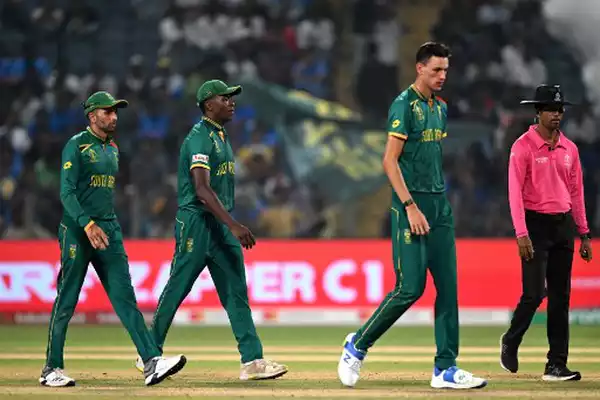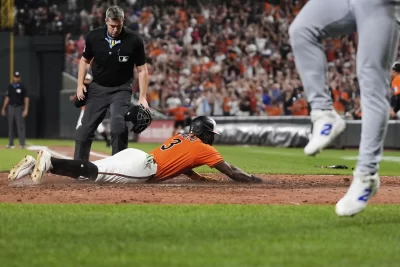
What if it happens again? The assault India’s top order inflicted on South Africa’s respected attack during the powerplay of their men’s World Cup match at the Eden Gardens on Friday, that is. Eric Simons’ reply to the question was understandably cagey.
“We do have very specific tactics about what we would do in certain situations – who we would want to bowl to and who we wouldn’t want to bowl to,” Simons, South Africa’s bowling coach, told a press conference on Wednesday. “But I wouldn’t want to talk about it in this situation.”
“We need to analyse who’s coming at us, who’s not, what their strike rates are and how you manage how many balls you bowl at them. We try to use field placings as much as we can to create pressure. We want bowlers to bowl the same balls that we plan to, and then use field placings to create pressure.”
That’s all very well, but it didn’t work on Sunday. Instead India smashed and grabbed 91 runs off the first 10 overs at the cost of one wicket. South Africa are unlikely to come under the same level of pressure in their last league match against Afghanistan in Ahmedabad on Friday. But they can be sure Australia, who they seem set to face in a semifinal in Kolkata next Thursday, will have taken notes on how the Indians did what they did.
The Australians already have an idea. Only once in the tournament have any side scored more runs during the first-innings powerplay than India managed on Sunday – in Dharamsala on October 28, when the Aussies made 118 without loss against New Zealand.
South Africa’s next most expensive opening 10 overs when they have fielded first was against Pakistan in Chennai on October 27, when they went for 58/2: fewer runs than have been recorded 14 times in the first 10 overs of the 40 matches played so far.
The South Africans never recovered from India’s early blast. They conceded a total of 326/5 and were dismissed for 83 to record their heaviest defeat in all 667 of their ODIs, an embarrassing result for a side who had gone into the match as the second-strongest side in the competition.
It seems unfair to cast Marco Jansen as the villain of this piece, but it’s also difficult to not do so. Jansen had taken a tournament-leading dozen wickets in the powerplay going into Sunday’s game – when he was smashed for 43 in his first four overs and finished with 1/94 in 9.4. Jansen sent down four wides in his first over, one of which scooted to the boundary, and was clearly rattled beyond a level he knew how to counter at 23 and in only his 22nd ODI.
“He went away from concentrating on himself to concentrating on the opposition, which sometimes happens in pressure moments when you’re up against the quality of the batsmen we were playing against,” Simons said. “His focus moved away from the way he’d been bowling to the opposition in the situation. It’s a case of getting it back there.
“When you start getting out of your bubble and start worrying about what’s on the other side of the pitch, and not what you’re doing on your side, that can create the problem. We mustn’t forget he’s a young cricketer who’s new to the international game, and these moments will happen. But he’s pretty calm about it.
“You learn from it as best you can, and I do think we have and we will. You have those moments where the red mist can slip in. When you look back on it you realise you weren’t calm, you weren’t in the moment, you weren’t what all the beautiful comments say. But the conversations have been really good and positive.”
What would Simons do to get the 2.06-metre fast bowler back on track for Friday’s match? “I can’t put my arm around his shoulder because it’s too high – I can’t reach it!” But seriously: “There’s potential and then there’s performance. He’s bowled at a certain level and then you see a performance that’s off. What is the noise in the system between how you’ve performed and the way you’ve been able to perform?
“Four points have come out of our conversation that we will focus on to make sure that, if he comes under pressure again, we address those things. None of those four things are technical. What noise in the system has created the gap between how he actually bowled and the way we know he can bowl?”
None of which should suggest a shift in selectoral approach for a team who, unless forced by injuries, have picked the same XI save for the inclusion of either Gerald Coetzee or Tabraiz Shamsi. “I don’t think we’re going to get carried away with changes due to the frustration of one particular powerplay,” Simons said. “We’ve been outstanding in the powerplay. We’ve spoken about a bowling unit that understand their roles and have settled into those roles. We don’t want to over-analyse one performance which we weren’t as happy with as we have been with others.”
Simons didn’t say so outright, but between his lines could be read the inference that South Africa would face India again at this tournament: in the final in Ahmedabad on November 19.
“We’ve been really good in the powerplay,” Simons said. “Where India have been a little better is in their consistency of accuracy. That’s been a hallmark of the way they’ve bowled to build pressure and take wickets. I’d like to see their attack under pressure in the middle overs when they haven’t taken wickets. That’s a gap that could occur. They haven’t been tested at all like that.
“We’ve come away from the game against India with questions to be answered and discussions to be had, and you may find they’ve gone away with very few. They probably haven’t questioned the way they’ve gone about the game – what they have done and what they haven’t done. That might be a chance for us to be one step ahead of them.
“Their technical ability – the way they get the seam in position, the way they can move the ball in both directions … we’ve seen more and more of our guys doing it. Our seams have got better during the course of the tournament, and we’ve been able to move the ball in both directions.”
These are big ideas for a side who have won only one of the six knockout games they have played at the World Cup; a team who have yet to reach a final, much less won it. But, as India’s bowling consultant in their successful 2011 campaign, Simons knows what it takes to claim the trophy. What were his chances of adding a South African triumph to his curriculum vitae?
His answer to that question, too, would be cagey. But, significantly for a team who only just qualified directly for the tournament and were not considered threats at the outset, it is only right that it should be asked.






